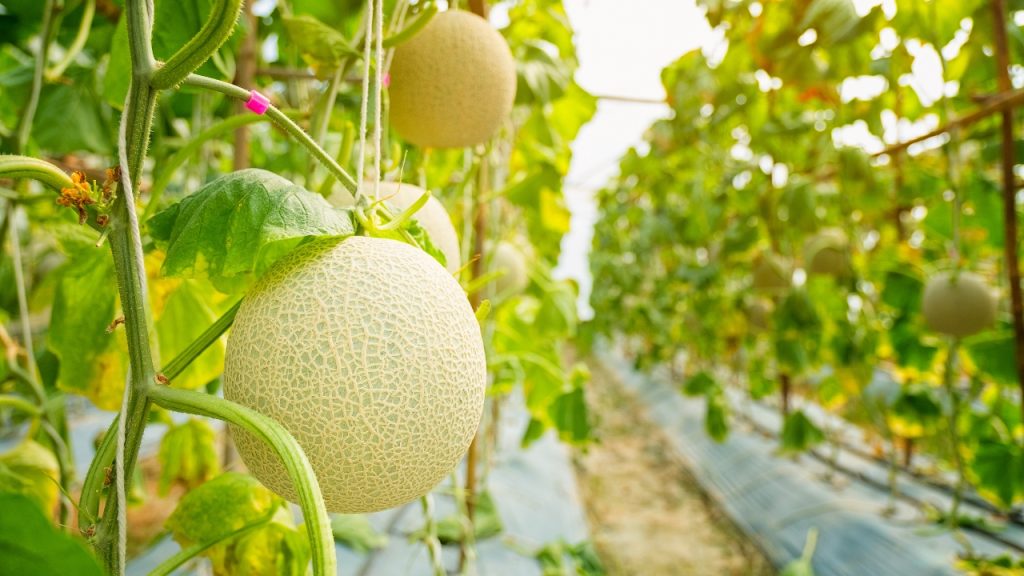Cantaloupes, with their juicy and sweet flesh, are a delightful addition to any garden. Growing your own cantaloupes through the art of Cantaloupe Gardening not only provides you with an abundant supply of delicious fruits but also allows you to experience the joy of nurturing and harvesting your own produce. In this comprehensive guide, we will explore various tips and techniques to help you elevate your garden with Cantaloupe Gardening, ensuring a successful and rewarding melon-growing journey.
1. Choosing the Right Cantaloupe Varieties:

Selecting the right cantaloupe varieties is crucial for a successful garden. Consider factors such as your climate, available space, and personal taste preferences. Popular varieties include Athena, Hale’s Best, Ambrosia, and Sweet Granite. Research different varieties to find the ones that are well-suited to your specific growing conditions.
2. Preparing the Soil:

Cantaloupes thrive in well-draining, fertile soil. Prior to planting, prepare the soil by removing any weeds or debris. Incorporate organic matter, such as compost or well-rotted manure, to improve soil fertility and moisture retention. Perform a soil test to determine the pH level and make necessary amendments to achieve a slightly acidic to neutral pH range of 6.0 to 7.5.
3. Starting Cantaloupe Seeds Indoors:

For early planting, start cantaloupe seeds indoors about 4-6 weeks before the last frost date. Use seed trays or pots filled with a quality seed-starting mix. Plant the seeds at a depth of 1/2 to 1 inch. Maintain a warm temperature of around 75-85°F (24-29°C) and provide adequate sunlight or artificial light to encourage healthy seedling growth.
4. Transplanting Seedlings:
Once the danger of frost has passed and seedlings have developed two to three true leaves, they are ready for transplanting. Choose a sunny location in your garden with at least 6-8 hours of direct sunlight per day. Space the seedlings about 2-3 feet apart to allow for proper airflow and growth.
5. Providing Optimal Growing Conditions:
Cantaloupes thrive in warm climates, requiring a long growing season of approximately 80-100 days. Ensure the plants receive consistent moisture throughout their growth. Water deeply and evenly, keeping the soil moist but not waterlogged. Mulching around the plants helps retain soil moisture, suppresses weed growth, and maintains even soil temperatures.
6. Supporting and Training Vines:
Cantaloupes are vining plants that benefit from support and training. Use trellises, cages, or stakes to provide vertical support, allowing the vines to grow upward. This technique saves garden space, promotes better airflow, and makes harvesting easier. Gently secure the vines to the support structure using soft ties or garden twine.
7. Pruning and Thinning:
To enhance airflow and maximize fruit production, selectively prune cantaloupe vines. Remove excessive foliage and suckers, focusing on maintaining a balance between vegetative growth and fruit production. Thin out fruits by removing smaller or damaged ones, ensuring the remaining melons have enough space to develop fully.
8. Fertilizing Cantaloupe Plants:
Supplying adequate nutrients is crucial for healthy plant growth and fruitful yields. Prior to planting, incorporate a balanced organic fertilizer or slow-release granular fertilizer into the soil. As the plants grow, side-dress them with a nitrogen-rich fertilizer during the early stages and transition to a phosphorus and potassium-rich fertilizer as they begin to flower and set fruit.
9. Managing Pest and Disease:
Keep a close eye on your cantaloupe plants for signs of pests and diseases. Common pests include aphids, cucumber beetles, and squash bugs. Regularly inspect the leaves and stems, and promptly remove any pests you encounter. Consider natural pest control methods such as introducing beneficial insects like ladybugs or using organic insecticidal soaps. For diseases like powdery mildew or fungal infections, provide adequate spacing between plants, promote good airflow, and apply organic fungicides if necessary.
10. Proper Harvesting:
Knowing when to harvest your cantaloupes is crucial for optimal flavor and texture. The most reliable indicator is the fruit’s aroma—ripe cantaloupes emit a sweet, fragrant scent. Additionally, observe the color change of the melon’s rind from green to beige or yellowish, and check if the fruit easily detaches from the vine with a gentle twist. Harvesting too early can result in bland or underdeveloped fruit, while waiting too long can lead to over ripeness and reduced quality.
11. Storing and Enjoying Your Cantaloupes:
To extend the shelf life of your harvested cantaloupes, store them in a cool, well-ventilated area. If refrigerating, place them in a plastic bag to retain moisture. Whole cantaloupes can typically be stored for 5-7 days, while cut melons should be consumed within a few days. Enjoy the refreshing flavor of freshly harvested cantaloupes by adding them to fruit salads, blending them into smoothies, or simply enjoying them as a healthy snack.
12. Seasonal Care and Crop Rotation:
After harvesting, it’s important to care for your garden and prepare for the next growing season. Remove any remaining plant debris and weeds to reduce the risk of pests and diseases overwintering. Consider implementing crop rotation by not planting cantaloupes or other related plants (cucumbers, squash, etc.) in the same area for consecutive years. Crop rotation helps break pest and disease cycles and improves soil health.
13. Continuous Learning and Adaptation:
Gardening is a continuous learning process, and each growing season presents new challenges and opportunities. Stay updated with gardening resources, books, and online forums to expand your knowledge and skills. Adapt your techniques based on your garden’s specific conditions and learn from both successes and setbacks. Experiment with different varieties, planting methods, and pest control strategies to refine your Cantaloupe Gardening expertise.
Conclusion:
Elevating your garden with Cantaloupe Gardening can be a rewarding and flavorful experience. By following these tips and techniques, you can successfully grow and enjoy delicious cantaloupes in your own backyard. From selecting the right varieties to providing optimal growing conditions, maintaining plant health, and harvesting at the peak of ripeness, each step contributes to a bountiful harvest. Embrace the journey of Cantaloupe Gardening, and savor the joy of growing and indulging in your homegrown melons.

